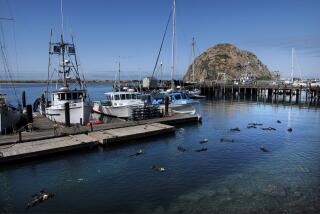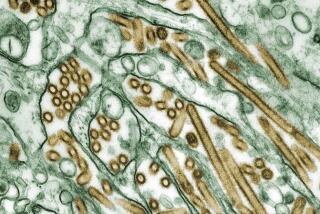A Sewage Plume Comeback?
A new study says the massive plume of partially treated sewage piped off the coast of Huntington Beach could have contributed to the extended closure of a miles-long stretch of the city’s shoreline in 1999 and might be causing continued high bacterial counts in that area.
The Orange County Sanitation District, which has a federal waiver allowing it to dump the partly treated sewage four miles offshore, has long said the polluted plume does not come on shore. The joint study by UC Irvine and Scripps Institution of Oceanography in La Jolla says evidence indicates otherwise.
It could provide ammunition to environmentalists who oppose an extension of the waiver, which expires next year.
“We don’t have a smoking gun here--we can’t say we have seen a time when [the sewage] has reached the beach,” said Clinton D. Winant, a study co-author and a professor of oceanography at Scripps. “But it would also be wrong to say the [sewage] can’t reach the beach.”
The study, though independent of the sanitation district, was based on the agency’s data and was published on the Web site of the American Chemical Society’s Environmental Science & Technology journal this week. It will be published in the journal in May.
Scientists have been studying high bacteria counts at Huntington Beach since the summer of 1999, when county health officials closed miles of shoreline for more than a month. The cause of the closure during the city’s peak tourist season has never been determined. Every summer since, bacteria counts have spiked at the beach.
Numerous theories have been put forth. Most recently, research has focused on the sewage plume, piped out at a rate of 243 million gallons a day.
“Clearly, the sanitation district’s own evidence cries for [higher] treatment,” said Assemblyman Ken Maddox (R-Garden Grove), who has sponsored a bill that would kill the waiver.
The study discredits a theory that sewer officials here and around the nation have long relied upon--that the sewage discharged into the ocean is trapped in cold water far offshore, and that the cold water in turn is trapped by a warmer layer of water on top of it. The study finds that underwater waves can push the cold water to the beach--especially during late spring, the summer and early fall, when beaches are busiest.
“We now know that that warm layer is not a permanent fixture and that colder waters can sometimes rise and come all the way up to the beach,” Winant said. “Since sewage ends up in the cold water, there’s a chance that it could come to the beach as well.”
Winant suggested that during the summer, if the water is cold, parents might want to reconsider letting their children play in it.
“Most people don’t worry about this, and I haven’t until now,” he said. “Now maybe I will.”
Sanitation district spokeswoman Lisa Murphy said Wednesday that the district analyzed the same data and in September 2001 concluded that it provided little evidence that the cold water had moved onshore. She added that the closest the plume has been found to the beach is a half-mile offshore, 45 feet underwater.
Winant, who wrote the study with UCI professors Alexandria B. Boehm and Brett F. Sanders, said the project shows that more research is needed.
“I’m a scientist--let’s do more studies,” he joked.
“We need to understand what happens in the ocean environment in a comprehensive way,” he said. “We’re dumping all this stuff into the ocean, and we really don’t understand what’s going on in that box out there.”
The study was praised by Stanley Grant, a UCI professor who first theorized that the plume could be causing high bacteria counts at the beach. He was not affiliated with the study, but he has reviewed it.
“It’s a very solid piece of work,” he said. “It certainly demonstrates that material can move across the [ocean] by internal tides, which is a very important ingredient to this idea that the plume can move ... into the surf zone.”
But Grant suggested that research is needed to determine whether the AES power plant in Huntington Beach plays a role. The plant’s cooling system pulls in ocean water, he said, and could be drawing the plume back to shore.
Environmentalists and other waiver opponents say the study is the latest evidence that the waiver should be eliminated.
The sanitation district is the largest of 36 agencies nationwide to have waivers allowing them to dump sewage that has not all received secondary treatment.
“It’s beyond possible” that the sewage reaches the beach, said Tod W. Ridgeway, Newport Beach mayor and a member of the district board. “It’s probable.
“Under all circumstances, we oppose the granting of the waiver,” he said.
Board member John M. Gullixson said he is awaiting the results of a $5.1-million study the district conducted last year to see if the plume was coming onshore. He noted that the district is about to begin chlorinating the plume to reduce the amount of disease-causing microorganisms.
“I’m just continuing to gather the information,” said Gullixson, also a Yorba Linda councilman. “I’m still not convinced one way or the other.”
More to Read
Sign up for Essential California
The most important California stories and recommendations in your inbox every morning.
You may occasionally receive promotional content from the Los Angeles Times.











